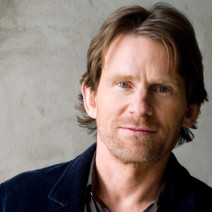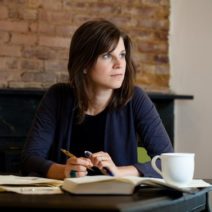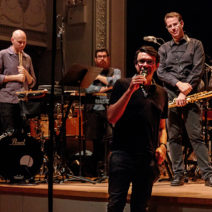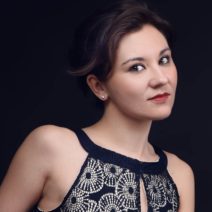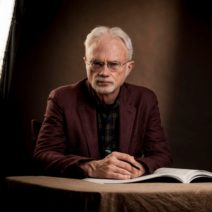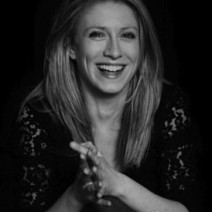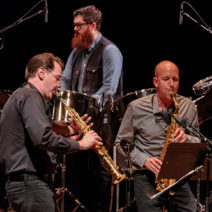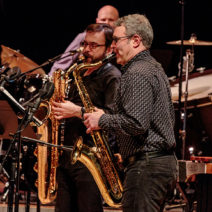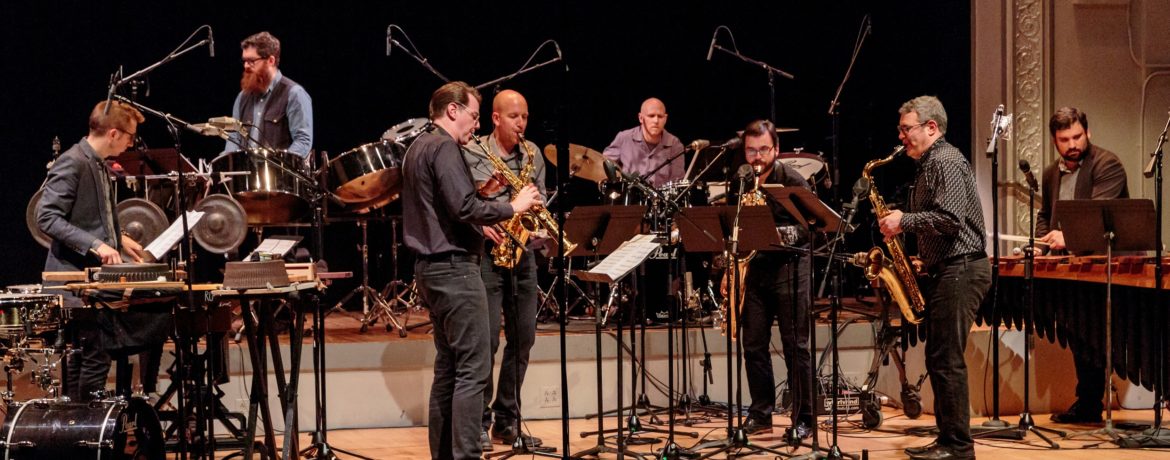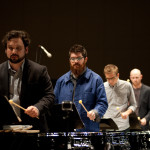Steven Mackey: Blue Notes and Other Clashes A common thread running through my musical life has been a fascination with the right wrong notes. This is true for me as an electric guitar player, bending blue notes, and as a...
Steven Mackey: Blue Notes and Other Clashes
A common thread running through my musical life has been a fascination with the right wrong notes. This is true for me as an electric guitar player, bending blue notes, and as a concert music composer seeking more unusual hues. I am drawn to the note that subtly bends my ears or snaps them to attention – the note that hurts so good. Writing the right wrong note is not exclusively and act of harmony. There is a whole spectrum of wrongitude that could paint an event with a pronounced color. Blue Notes and Other Clashes employs – off-kilter rhythms, peculiar orchestrations and quirky formal designs, as well as pitch bends, microtonal fingerings, detuned steel pans, ambiguously (un)pitched percussion and the corruption of otherwise simple harmonic contexts in order to achieve some sort of crippled grace, and rough beauty. – S.M.
Steven Mackey was born in 1956, to American parents stationed in Frankfurt, Germany. He is regarded as one of the leading composers of his generation and has composed for orchestra, chamber ensembles, dance and opera. He has received numerous awards including a Grammy in 2012. His first musical passion was playing the electric guitar in rock bands based in northern California. He blazed a trail in the 1980s and ’90s by including the electric guitar and vernacular music influence in his concert music and he regularly performs his own work, including two electric guitar concertos and numerous solo and chamber works. He is also active as an improvising musician and performs with his band, Big Farm. He serves on the faculty of Princeton University. www.stevenmackey.com
Donnacha Dennehy: The Pale
The “Pale” was the area encompassing Dublin and its environs where British rule was at its strongest in the 14th century. In fact they even protected this area with ditches and fences to keep the barbarous, thuggish Irish out – the great unwashed were, as the phrase became, “beyond the pale.” I wanted to write obsequious, fawning music to glorify the wisdom of our great and holy leaders in their attempts to build new Pales for the twenty first century. With healthy bounding major chords and stirring marches I could in my own small way honor their omnipotence and visionary leadership. However like the original Pale I failed. Well, at least, only 700 years later, things are starting to work out. This piece may fawn more 700 years from now too. – D.D.
Born in Dublin in 1970, Donnacha Dennehy has received commissions from today’s leading new music artists and ensembles, including Dawn Upshaw, the Kronos Quartet, Bang On A Can, Lucilin (Luxembourg), Orkest de Ereprijs (Netherlands), RTE National Symphony Orchestra, the St. Paul Chamber Orchestra, BBC Ulster Orchestra and the San Francisco Contemporary Music Players. He has collaborated with writers Enda Walsh and Colm Tóibín, choreographers Yoshiko Chuma and Shobana Jeyasingh, and the visual artist John Gerrard. He is the founder of Ireland’s renowned new music group Crash Ensemble, and serves on the faculty of Princeton University. www.donnachadennehy.com
John Adams: Fearful Symmetries
PRISM member Timothy McAllister has arranged an excerpt of John Adams’s Fearful Symmetries. Adams composed the work for orchestra in 1988, after the first series of performances of his opera, Nixon in China. He states, “The music is, as its title suggests, almost maddeningly symmetrical. Four- and eight-bar phrases line up end to end, each articulated by blazingly obvious harmonic changes and an insistent chugging pulse… It’s clearly an example of what I call my ‘travelling music,’ music that gives the impression of continuous movement over a shifting landscape. In this piece, however, a cityscape is doubtless the more appropriate analogy as the sound has a distinctly urban feel. It is for sure a seriously aerobic piece, a Pantagruel boogie with a thrusting, grinding beat that governs at least two-thirds of its length… What appeals to me most about the piece is the timbre: It mixes the weight and bravura of a big band with the glittering, synthetic sheen of techno pop (samples and synthesizer) and the facility and finesse of a symphony orchestra.”
Composer, conductor, and creative thinker—John Adams occupies a unique position in the world of American music. His works, both operatic and symphonic, stand out among contemporary classical compositions for their depth of expression, brilliance of sound, and the profoundly humanist nature of their themes. Le Monde wrote that his music “gives the impression of a rediscovered liberty, of an open door which lets in the fresh air in great gusts.” He is the recipient of the Pulitzer Prize for Music, the Grawemeyer Award, and multiple Grammy awards.
Nina C. Young: Tarnish
Rome Prize winner Nina C. Young writes that Tarnish is inspired by the alteration of material on the surface of metal, “the thin layer of corrosion that forms as certain metals undergo a chemical reaction. Only the top few layers react; the outer destruction seals and protects the underlying structure. Tarnish begins and ends with gentle noise. From this initially unpitched sound world the Quartet uncovers (wipes away the tarnish from) timbral layers to expose nostalgic, tonal, almost-saccharinely beautiful music. These sections are intended to be very precious, but short-lived. When exposed for too long, they oxidize.”
Assistant Professor of Composition and Director of Electronic Music at UT Austin, Nina C. Young’s unique musical voice draws equally from elements of the classical canon, modernism, spectralism, American experimentalism, minimalism, electronic music, and popular idioms.
Emma O’Halloran: Night Music
“…burning for the ancient heavenly connection to the starry dynamo in the machinery of night…” – from Howl by Allen Ginsberg. Night Music is a reflection on a year I spent living in Miami in my early twenties. I had never previously lived abroad, and for the entire year I was in sensory overload. I loved the music, the weather, and the people, but I also experienced a lot of culture shock having come from a relatively small town in the middle of Ireland. There were moments when I felt so connected to everything around me, and then other times when things shifted out of focus like I was having an outer body experience. For the times when I felt like parts of me were slipping away, I would go to the beach at night and listen to the sounds of the ocean. I was also influenced by Latin dance music, and this piece tries to recreate some of those sounds – the music you’d hear in the clubs in Miami, and also the music of Miami Sound Machine. – E.O.
Emma O’Halloran is an Irish composer who writes music for acoustic and electronic instruments. In addition to concert music, she composes for theater, and is one half of the electronic duo Games Violet. She lives in New Jersey, and is currently a doctoral fellow at Princeton University. thisisemmao.com
